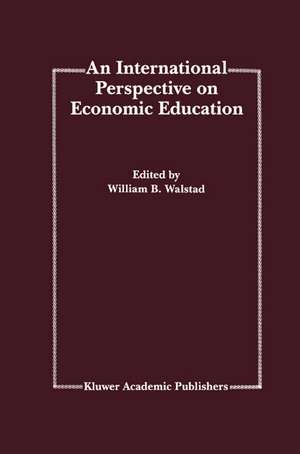An International Perspective on Economic Education
Editat de William B. Walstaden Limba Engleză Hardback – 31 ian 1994
The teaching of economics in secondary schools varies across countries. These differences occur because of history, the structure of education, and other national factors. At the same time, there are common elements in the economic education of many countries, especially in content coverage. This contrast between the common features and the uniqueness of economic education in secondary schools of major industrial nations exemplifies the international perspective presented in this book.
The international perspective is developed in the six sections of the volume. The first section discusses why nations should include economics in school curricula, and presents a framework for teaching economics that should have global appeal. Dissension and consensus on economic issues among North American and European economists are examined in the second section. The third section surveys the U.S. research literature on precollege economic education and assesses the current state of economics instruction in U.S. schools. The economics curricula and educational practices in seven other nations -- the U.K., Canada, Japan, Germany, Austria, Korea, and Australia -- are described in the fourth and fifth sections. The fifth section also presents international comparisons of economic understanding based on national testing in six of those nations. The sixth and final section explores the role of economic education in centrally planned economies, and its effects on the transition to a market economy, using Russia, Bulgaria, and China as case studies.
| Toate formatele și edițiile | Preț | Express |
|---|---|---|
| Paperback (1) | 945.62 lei 6-8 săpt. | |
| SPRINGER NETHERLANDS – 2 oct 2012 | 945.62 lei 6-8 săpt. | |
| Hardback (1) | 951.91 lei 6-8 săpt. | |
| SPRINGER NETHERLANDS – 31 ian 1994 | 951.91 lei 6-8 săpt. |
Preț: 951.91 lei
Preț vechi: 1160.86 lei
-18% Nou
Puncte Express: 1428
Preț estimativ în valută:
182.14€ • 190.19$ • 150.41£
182.14€ • 190.19$ • 150.41£
Carte tipărită la comandă
Livrare economică 15-29 aprilie
Preluare comenzi: 021 569.72.76
Specificații
ISBN-13: 9780792394372
ISBN-10: 0792394372
Pagini: 299
Ilustrații: XV, 299 p.
Dimensiuni: 155 x 235 x 19 mm
Greutate: 0.63 kg
Ediția:1994
Editura: SPRINGER NETHERLANDS
Colecția Springer
Locul publicării:Dordrecht, Netherlands
ISBN-10: 0792394372
Pagini: 299
Ilustrații: XV, 299 p.
Dimensiuni: 155 x 235 x 19 mm
Greutate: 0.63 kg
Ediția:1994
Editura: SPRINGER NETHERLANDS
Colecția Springer
Locul publicării:Dordrecht, Netherlands
Public țintă
ResearchCuprins
1. An Introduction to an International Perspective on Economic Education.- I. Rationale and Framework for Economic Education in the Schools.- 2. Economic Education for a Half-Century of Radical Change.- 3. A Global Framework for Teaching Economics.- II. Consensus and Dissension in Economics and the Effects on Economic Education.- 4. Economists’ Ideological Conflicts and Consensus on Economic Issues, and Their Implications for Economic Education.- 5. A Comparison of the Views of Economists, Economic Educators, Teachers and Journalists on Economic Issues.- III. Research and Assessment of High School Economics in the United States.- 6. Research on High School Economics in the United States: Further Considerations.- 7. An Assessment of Economics Instruction in American High Schools.- IV. Economic Education in Secondary Schools in Other Nations.- 8. Economic Understanding in the United Kingdom.- 9. The Canadian Experience and the Lasting Impact of Economic Education.- 10. The Canadian Experience and the Lasting Impact of Economic Education.- V. Comparisons of Economic Understanding Across Nations.- 11. Economic Literacy in German-Speaking Countries and the United States: Methods and First Results of a Comparative Study.- 12. Economic Literacy in the Republic of Korea and the United States.- 13. High School Economics in Australia.- VI. The Role of Economic Education in a Transition to a Market Economy.- 14. The Changing Face of Economics Instruction in Russia.- 15. Economic Education and Transition in Eastern Europe.- 16. High School Economics in the People’s Republic of China.












